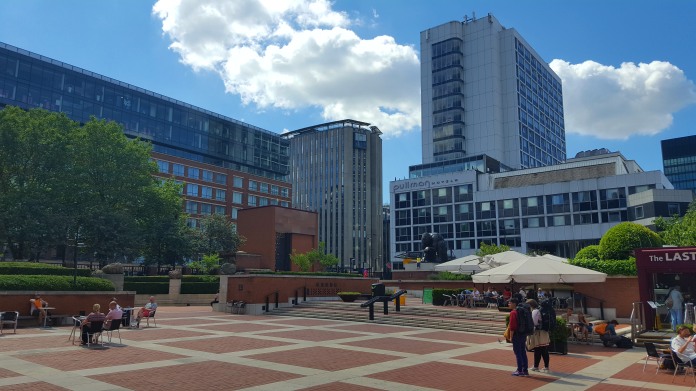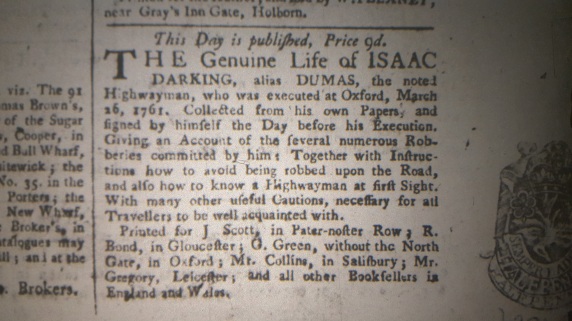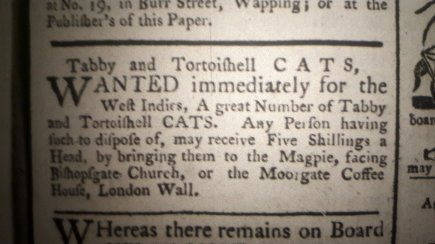
The view from the entrance of the British Library, London.
These last three weeks have seen Stephen (@DrStephenMullen) and myself in the British Library, searching through the microfilms of the Burney collection.
While the Burney collection of newspapers are available to search online (usually through libraries or education institutes), word searches only catch as much as the original text reader recognises. Using an Optical Character Recognition (OCR) program, databases like the Burney collection and the British Newspaper Archive can provide rough estimates of what is written on the various pages by high quality scanning or photographing the originals, and letting the OCR assign letters.
Unfortunately, however, this is far from foolproof. As an example, a recent search for “tawny” (an 18th century term for a yellowy hue, and one often used to describe people from Asia), provides results like “town”; a search for “slave” will not provide many hits as the OCR (and many of us initially!) often recognise the lower case “s” used during this period as a lower case “f” (see examples in the word “Sense” in the last excerpt) – thus a search for “flaves” actually gives us better results.
This can be combated somewhat by searching other terms that would appear in the advert – reward, master, and the like. This narrows down the probability of the OCR fudging results. However, while these searches provide a large amount of our data, we find enough adverts to justify spending time going through the 18th century newspapers on microfilm, page by page. Anyone that has spent time studying microfilm knows how tough it can be over extended periods. This is offset, firstly, by the knowledge that we’re in a very fortunate position, but also by the fantastic finds you can come across.
Newspapers are essentially a huge window into the social life of the period. Amongst other functions, they provide us insight into important events during the period in the news reports; what people were worried about in letters to the editor; the items people sought and bought in the advertisements, and various other data that, really, I could talk all day about. Every snippet can help fill our mental model, our representation, of the 18th century, constantly adding to this wonderful jigsaw we study. I usually share these snapshots on twitter for interest and feedback from other academics. Apart from building collegiality across the internet, and reaching people places you might never have considered, it’s good practice – I still think collaboration can only help us and our discipline become better.
And so, in the months after, I don’t think back on the hours spent trawling the microfilm, but the individual bits and pieces that really struck me as unique or interesting. These were some of my most interesting finds this trip, all from the 1760’s Public Ledger.
Cashing on the life & advice of former Highwayman

This day is published, Price 9d.
THE Genuine Life of ISAAC
DARKING, alias DUMAS, the noted
Highwayman, who was executed at Oxford, March
26, 1761. Collected from his own Papers, and
signed by himself the Day before his Execution.
Giving an Account of the several numerous Rob-
beries committed by him: Together with Instruc-
tions how to avoid being robbed upon the Road,
and also how to know a Highwayman at first Sight.
With many other useful Cautions, necessary for all
Travellers to be well acquainted with.
Printed for J Scott, in Pater-noster Row; R.
Bond, in Gloucester; G. Green, without the North
Gate, in Oxford; Mr. Collins, in Salisbury; Mr.
Gregory, Leicester; and all other Booksellers in
England and Wales.
This raises some interesting questions. Did Dumas, cosied up and staring into the fire in his hideaway after yet another successful robbery, think to himself “Well this is just getting too easy. These people are practically asking to get robbed” and furiously scribble notes on how he would have handled a fellow road robber? Unfortunately, I have yet to come across the book, but will be keeping an eye out for it. Not least so I can spot a Highwayman at first glance.
A real life mermaid?

THE Nobility, Gentry, &c. are hereby in-
formed, that there is just arrived, and is to be seen
in a very commodious room, the next door to the Queen’s
Head, opposite the Adelphi, in the Strand, the amazing
MERMAID, a creature very rare, remarkably curious,
and of astonishing structure and sight; it is the only one of
its kind ever seen in England, and in Europe since the Arch-
duke of Austria’s, which is upwards of two hundred and
twenty-six years. The wonderful Nymph of the Sea, half
a woman and half a fish, is near three feet long, and has
fins, gills, ears, arms, hands, fingers, breast and shoulders;
as also a contiguous scale covering the fish part. It is al-
lowed by all of them that have seen it to be the mist beau-
tiful and curious creature of its kind ever seen in the
world.
N.B. It may be seen by any body even by the women
big with child without the least degree of danger, for he
that shews it is prudent and cautious. Price is 1s. 6d. per
head, upon which the print and history of it is delivered.
So many questions, in particular why was she only three feet long?
Cats wanted for the West Indies islands

This was a really exciting find, especially as a cat lover. It gave rise to an interesting discussion on twitter too – just what were the ill-fated felines going to be used for?
Tabby and Tortoishell CATS,
WANTED immediately for the
West Indies, A great Number of Tabby
and Tortoishell CATS. Any Person having
such to dispose of, may receive Five Shillings a
Head, by bringing them to the Magpie, facing
Bishopsgate Church, or the Moorgate Coffee
House, London Wall.




Almost certainly, the answer was for vermin control – Prof. Simon Newman has said that the sugar canes on plantations attracted rats in their thousands, and the cats would be used to keep their number down and protect the lucrative crop.
Life advice for women (!)
I had to stifle a laugh in the library as I found this excerpt. Surrounded by strong women growing up (and since!), I can only imagine their choice words to anyone daring to sing this piece!

SONG.
I.
KITTY had all the modes of dress,
Of Beauty ample share;
Betsey had charms enough to bless,
Of dress just decent care.
II.
Betsey had sense and modesty,
Fair Virtue was her guide;
Kitty had Conquest in her eye,
And Folly – at her side.
III.
Kitty to Coxcombs gave her ear,
Still pleas’d to be admir’d;
Sense Betley’s virtue found most fair,
And Sense her charms desir’d.
IV.
Kitty to Folly gave her hand,
And liv’d a wretched life;
Betsey pursu’d what Sense had plann’d,
Became a happy wife.
V.
The charms of Kitty’s face decay’d,
Which Folly had enjoy’d;
While Betsey’s virtue was repaid,
For Sense was never cloy’d.
What may seem as a fairly innocuous five verse ditty, is in reality an attempt to undermine women’s freedom. The warning that Kitty’s example presents – that focusing on your beauty, garnering attention for the wrong reasons (Coxcombs is a synonym for a pretentious fop), not marrying – is contrasted to the situation Betty finds herself in by following the approach the author deems sensible, being a ‘good little housewife’. I will definitely be doing another post or two on the attitudes toward women in the press, as there really are copious examples of the chauvinistic and patronising behaviour.
Stephen and I will be back in London and the British Library reading rooms for at least six weeks before the end of the year – if you’d like to meet up and chat please get in touch.

I love old press like this. Anything with medial S’s in it is just about my favo(u)rite read.
LikeLiked by 1 person
Thanks for the comment! I will regularly (once a month ish) be updating this blog, and our project blog at http://www.runaways.gla.ac.uk/blog/
LikeLike